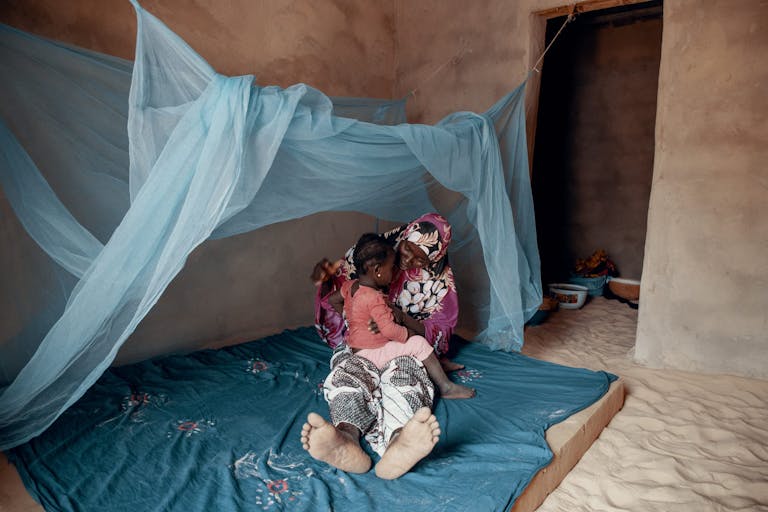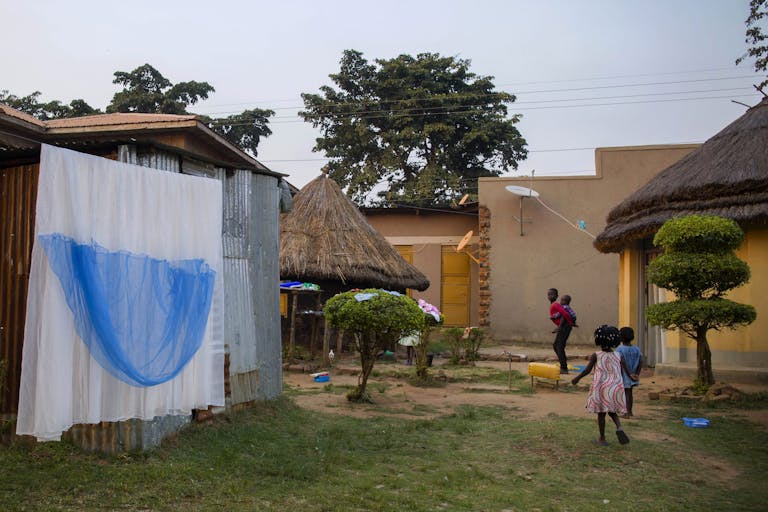Global health partners are adapting how they work to care for both communities and the environments in which they live. Vestergaard, a company that has manufactured long-lasting insecticidal nets for decades, is transforming its approach to manufacturing bed nets by using recycled materials to produce more eco-friendly malaria prevention tools to help protect the health of both people and planet.
Malaria remains one of the deadliest infectious diseases on the planet, with nearly half the world’s population living in areas at risk. In 2019, there were an estimated 229 million cases of malaria, and 409,000 deaths — most of them children under 5.
The COVID-19 pandemic has made global malaria worse, causing disruptions to malaria prevention, testing, and treatment services as a result of global lockdowns and constrained supply chains. A new report by the Global Fund to Fight AIDS, Tuberculosis and Malaria shows the COVID-19 pandemic has led to steep decreases in malaria diagnosis and treatment disruptions, with antimalarial medicine doses for children under 5 being out of stock due to supply chain constraints.
But global partners are fighting back with innovations to ensure services can continue and increase access to effective prevention tools. As the global pandemic rages, novel approaches to increase bed nets’ effectiveness are underway, including considerations of how more sustainable manufacturing of bed nets could protect both people and planet.

The Power of a Bed Net
Without question, insecticidal-treated bed nets are one of the most cost-effective and successful tools to control and prevent the spread of malaria in communities around the world. Long-lasting insecticidal nets (LLINs) are treated with insecticide to kill malaria-carrying mosquitoes. This not only helps stop mosquitoes from reaching humans by providing a barrier, but it also helps stop the disease from spreading further by actually killing the pests. In the past decade, bed nets have saved hundreds of thousands of lives in malaria-endemic regions. Several countries have even managed to eliminate the disease thanks to the use of LLINs combined with services that increased access to malaria testing and treatment. To help limit the damaging impacts of COVID-19 and get back on track toward reaching global malaria targets, access to integrated malaria services, including effective LLINs, will be pivotal.
Protecting the Health of People and Planet
While LLINs offer countless advantages, there is a drawback: Bed nets and their packaging are predominantly made of polymer plastics such as polyester or polyethylene, which are major pollutants to the environment. Every year, approximately 200 million nets are distributed worldwide, imposing a considerable burden on the planet. By 2031, for example, over a million tons of polymer plastic will be delivered to Africa.
But there are things that can be done to limit the environmental impacts of these plastics. Recipient countries and donors of bed nets can take measures to reduce the waste from individual packaging of bed nets, such as opting for bulk packaging for mass malaria-prevention campaigns. However, designing an eco-friendly way to dispose of old nets too torn to be used remains an issue yet to be solved. Because of this, a lot of plastic from packaging and old nets ends up in waterways and eventually the ocean. While bed nets distributed in Africa constitute no more than 1-5% of the total plastic consumption annually, they generate more than approximately 150,000 tons of additional waste, accumulating in landfills, dumps, or the natural environment. In resource-poor settings, it is often difficult to dispose of waste in environmentally friendly ways. That’s why industries should make it easy for partners and consumers to opt for more sustainable solutions so that a tool designed to help keep people healthy doesn’t end up harming the planet.

Innovation Leads to Eco-Friendly Solutions
Vestergaard, a manufacturer of LLINs for decades, has made it its mission to ensure that people in malaria-endemic, hard-to-reach places have access to durable, highly effective, and sustainable malaria-prevention products. But the company has also come to recognize that more must be done to limit the environmental impact of its products.
Over the past two years, Vestergaard has been researching and developing technology to make bed nets out of 100% recycled and upcycled material. By changing the source of the raw materials for LLINs, Vestergaard has found a way to keep large volumes of plastic waste out of landfills and oceans. The use of sustainable bed nets like these would reduce carbon emissions and help mitigate climate change. This innovative technology could enable the company to manufacture new bed nets out of old ones without compromising on quality, making it possible to save lives and help the planet.
Forging Sustainable Partnerships for the Future
Only through a concerted effort by partners across multiple sectors can we begin to think about the possibility of eliminating malaria globally. However, the global community cannot stop at malaria elimination alone. Partnerships and close collaborations between malaria programs and those working to mitigate climate change will be vital to move toward more sustainability within the LLIN manufacturing industry.
Strong, cross-industry partnerships will enable the scaling up of environmentally friendly solutions, such as the recycling of old bed nets. Innovation and change will be needed across malaria programs at all levels, from transforming donor organizations’ approaches to financing bed nets, to rethinking implementing partners’ supply chain systems, to developing new collection systems for old nets to enable more sustainable bed net distribution. All measures will also be imperative to strengthen health systems and reduce the impacts of climate change. Working together, we can ensure that everyone, everywhere, has access to the malaria prevention tools they need — and accelerate efforts for a more sustainable planet.
Vestergaard is a proud sponsor of the UN Foundation’s Unite for Health campaign. We are all safer and stronger when we #UniteforHealth.
Featured image: Vestergaard



 View All Blog Posts
View All Blog Posts

